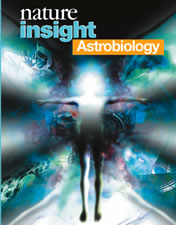Astrobiology
Vol.
409, No. 6823 (22 February 2001).
|![]() PDF
PDF![]() (138
(138![]() K)
K)![]() |
|
 |
Cover
illustration |
Commentators often bemoan what they see as the increasing tendency of research to be inward looking, self-serving and specialized. Happily, some things buck the trend. Astrobiology does this in dramatic fashion, and is the theme for the eclectic selection of review, progress and commentary that follows. Astrobiology is nothing less than the study of life in the Universe. It encompasses fields as diverse as geology, astronomy, evolutionary and developmental biology, human physiology and palaeontology.
A canvas so broad may lose its meaning — conversely, many researchers may be unaware that their narrow tasks could fall into the astrobiology net. To help define and explore the subject, a partnership between NASA and several universities has created the National Astrobiology Institute.
It would be easy to dismiss astrobiology as either a pointless fad or a new brand for goods long past their sell-by date (does anyone remember 'exobiology'?). But such condemnation misses the point. In an age of increased narrowness of research goals, it is invigorating to lift one's eyes to the stars and consider life in its broadest sense. One consequence of astrobiology will be to deepen our understanding of our own place in the Universe, our uniqueness and our potential.
As this collection of articles shows, many ventures labelled as astrobiology are quixotic, even romantic, perhaps some way from the usual stuff of science. Disagreement abounds, and answers to many astrobiological problems may never be found. But that there is no universal truth is true for all science: the stimulation is in the quest, not in the finding. How much more valid is that statement when the quest encompasses the spatial and temporal breadth of the cosmos?
Henry Gee Senior Editor
| Desperately
seeking aliens BRIAN W. ALDISS
| 1080 | ||
| The
habitat and nature of early life E. G. NISBET AND N. H. SLEEP
| 1083 | ||
| Life
in extreme environments LYNN J. ROTHSCHILD AND ROCCO L. MANCINELLI
| 1092 | ||
| Chance
and necessity: the evolution of morphological complexity and diversity
SEAN B. CARROLL
| 1102 | ||
| The
search for extraterrestrial intelligence T. L. WILSON
| 1110 | ||
| Humans
in space RONALD J. WHITE AND MAURICE AVERNER
| 1115 | ||
| Where
are the dolphins? JACK COHEN AND IAN STEWART
| 1119 | ||
